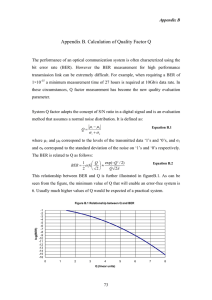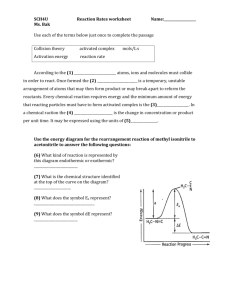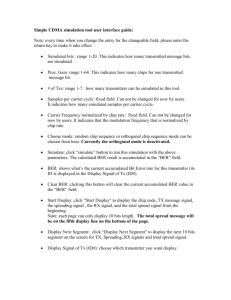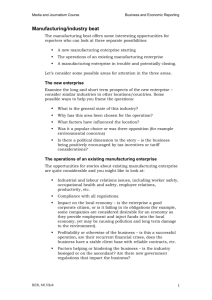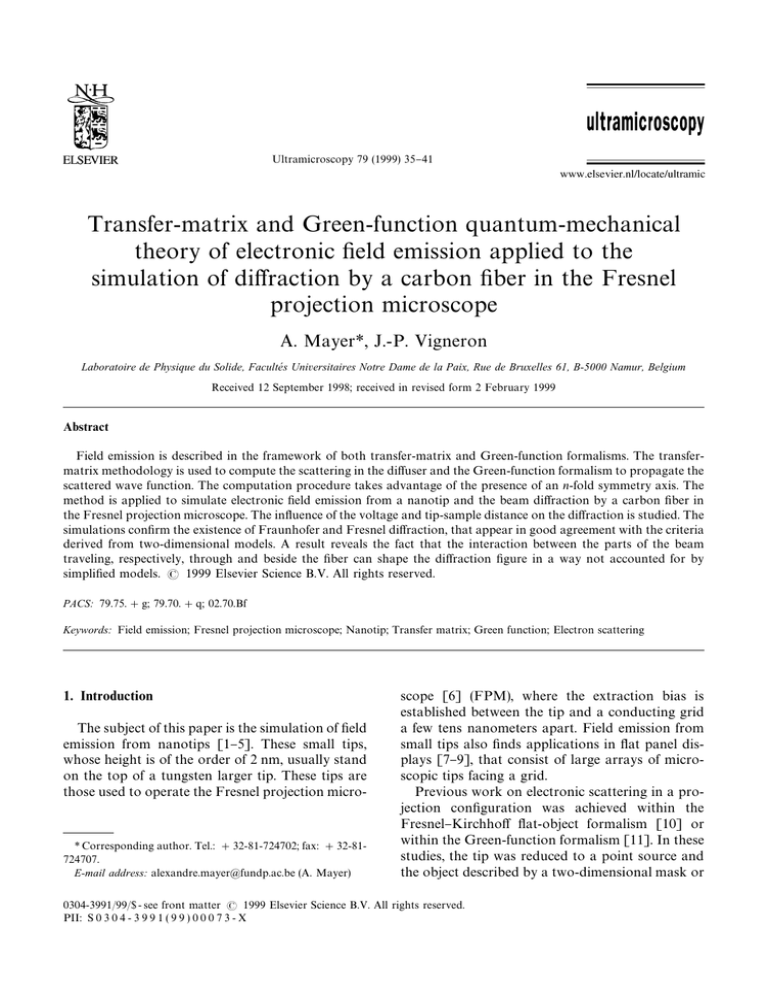
Ultramicroscopy 79 (1999) 35}41
Transfer-matrix and Green-function quantum-mechanical
theory of electronic "eld emission applied to the
simulation of di!raction by a carbon "ber in the Fresnel
projection microscope
A. Mayer*, J.-P. Vigneron
Laboratoire de Physique du Solide, Faculte& s Universitaires Notre Dame de la Paix, Rue de Bruxelles 61, B-5000 Namur, Belgium
Received 12 September 1998; received in revised form 2 February 1999
Abstract
Field emission is described in the framework of both transfer-matrix and Green-function formalisms. The transfermatrix methodology is used to compute the scattering in the di!user and the Green-function formalism to propagate the
scattered wave function. The computation procedure takes advantage of the presence of an n-fold symmetry axis. The
method is applied to simulate electronic "eld emission from a nanotip and the beam di!raction by a carbon "ber in
the Fresnel projection microscope. The in#uence of the voltage and tip-sample distance on the di!raction is studied. The
simulations con"rm the existence of Fraunhofer and Fresnel di!raction, that appear in good agreement with the criteria
derived from two-dimensional models. A result reveals the fact that the interaction between the parts of the beam
traveling, respectively, through and beside the "ber can shape the di!raction "gure in a way not accounted for by
simpli"ed models. 1999 Elsevier Science B.V. All rights reserved.
PACS: 79.75.#g; 79.70.#q; 02.70.Bf
Keywords: Field emission; Fresnel projection microscope; Nanotip; Transfer matrix; Green function; Electron scattering
1. Introduction
The subject of this paper is the simulation of "eld
emission from nanotips [1}5]. These small tips,
whose height is of the order of 2 nm, usually stand
on the top of a tungsten larger tip. These tips are
those used to operate the Fresnel projection micro-
* Corresponding author. Tel.: #32-81-724702; fax: #32-81724707.
E-mail address: alexandre.mayer@fundp.ac.be (A. Mayer)
scope [6] (FPM), where the extraction bias is
established between the tip and a conducting grid
a few tens nanometers apart. Field emission from
small tips also "nds applications in #at panel displays [7}9], that consist of large arrays of microscopic tips facing a grid.
Previous work on electronic scattering in a projection con"guration was achieved within the
Fresnel}Kirchho! #at-object formalism [10] or
within the Green-function formalism [11]. In these
studies, the tip was reduced to a point source and
the object described by a two-dimensional mask or
0304-3991/99/$ - see front matter 1999 Elsevier Science B.V. All rights reserved.
PII: S 0 3 0 4 - 3 9 9 1 ( 9 9 ) 0 0 0 7 3 - X
36
A. Mayer, J.-P. Vigneron / Ultramicroscopy 79 (1999) 35}41
a set of di!usive points representative of each atom.
In this paper, we present a method that takes us
beyond these limits, by bringing into the theory the
detailed three-dimensional electron potential-energy distribution between the metallic tip holder
and the object support conducting grid. This new
technique relies on both the transfer-matrix [12]
and Green-function formalisms. The details of our
method have been presented elsewhere [13}15].
The local scattering, which includes the "eld
emission phenomena, is considered within the
transfer-matrix methodology, since this formalism
has little storage requirements. The instabilities
inherent to this technique are controlled by
using the layer addition algorithm [16] with an
accuracy estimator [17]. Propagation is considered
within the Green-function formalism, since this
part of the problem is solved straight-forwardly
once the scattered wave function in the di!user is
known.
Our method is applied to the simulation of electronic di!raction by a carbon "ber, as in the
Fresnel projection microscope. The electronic
beam results from "eld emission from a nanotip.
This simulation aims at illustrating the dependence
of the di!raction "gure on the extraction bias and
tip-sample distance and at checking the criteria
derived by two-dimensional methods [10]. The
results reveal situations where the di!raction "gure
is shaped by a process that is not accounted for by
two-dimensional models. This process is due to the
interaction between the parts of the beam traveling,
respectively, through and beside the "ber.
2. Theory
2.1. Preliminaries
In our analysis, the metal is described using
a simple Sommerfeld picture, characterized by empirical values of = (work-function) and E (Fermi
$
energy), and delimited by the plane z"0. The
metal region z(0, with constant potential energy
< , is referred to as `region Ia. The conducting
grid is in the plane z"D. The region z'D, where
the potential energy is set conventionally to the
constant value 0, is referred to as `region IIIa. We
refer to the intermediate region 0)z)D, that
contains the emission nanotip and the sample, as
`region IIa. We could de"ne the peculiar planes
z"0 and z"D to be, respectively, inside the metal
and beyond the conducting grid in order to deal
with situations where the potential energy presents
non negligeable variations near the metal surface or
the conducting grid.
2.2. Wavefunction representation
In order to take advantage of situations where
the z-axis corresponds to a n-fold symmetry, the
scattering problem is formulated in cylindrical coordinates, by using the polar coordinates (azimuthal angle) and o (radial distance to the axis) in
the plane normal to the z-axis. Following the reference [18], the scattering electrons are assumed to
remain localized inside a cylinder of radius R in the
regions I and II. The following expression can then
be used to expand the wave function in these two
regions:
W(r)" U (z)t (o, ),
(1)
KH
KH
KH
where
t (o, )"J (k o)eK(/
KH
K KH
(2p0o[J (k o)] do and the wave vectors
K KH
k are solutions of J (k R)"0.
KH
K KH
2.3. Local scattering by the transfer-matrix
methodology
Since the potential energy takes a constant
value for z)0 and z"D, U (z) is analytic
KH
for these values and W(r) can be expanded in
terms
of
the
basic
states
W'! (r)"
KH
exp [$i((2m/
)(E!< )!k z] t (o, ) for
KH
KH
z)0 and W'''!(r)"exp[$i((2m/
)E!k z]
KH
KH
t (o, ) for z"D, where the roots are positive
KH
reals or complex numbers with positive imaginary
parts.
Each outgoing state W'''> can be considered
KH
individually and propagated backwards from
z"D to z"0, by using the SchroK dinger equation
and techniques given in references [13,14]. When
the corresponding wave function in z)0 is expanded along incident and re#ected basic states,
A. Mayer, J.-P. Vigneron / Ultramicroscopy 79 (1999) 35}41
the following set of solutions is obtained:
2.4. Propagation to the screen by
the Green-function methodology
XW
W'> # B
W'\
WM > M " A
KGK HM KH
KGK HM KH
KH
KG
KG
X"
.
" W'''>
K HM 37
(2)
Due to the linearity of the SchroK dinger equation,
these solutions can be combined to derive a set of
solutions corresponding to a single incident state
W'>
in region I:
K HM X
# t\> M W'\
W> M " W'>
K HM KHKH KH
KH KH
X"
" t>> M W'''>,
(3)
KHKH KH
KH
where the relevant transfer matrices t>> and t\>
are obtained from t>>"A\ and t\>"BA\.
The two transfer matrices t\\ and t>\ that describe the solutions corresponding to incident
states W'''\ coming from z"#R are obtained
KH
in a similar way.
The accuracy of the transfer-matrix computation
is improved when the distance D is split into several
adjacent layers and only the transfer matrices associated with each single layer are computed. The
transfer matrices corresponding to the whole distance D can be obtained in a "nal step by using the
relevant formulae developed by Pendry [16]. The
relative accuracy of the computation can be estimated [17] as a function of the number of layers
n
by the relation:
e "2\Le(K
4"L (cond(P)n
L
#(1#cond(P))n !2 cond(P)),
(4)
where < is the extraction bias, n the number of
binary digits used for the representation of the
fractional part of real numbers and cond(P) a number associated with the loss of accuracy due to each
combination of adjacent layers. The value of
cond(P) is typically around 5. This formula can be
used to predict the number of layers to use in order
to obtain a good accuracy. We recommend the
value n "4(2m/
<D/n ln 2 in order to ob tain results that have three quarters of the represented digits signi"cant.
Within the Green-function formalism, it is possible to derive the expression of a wave function at
an arbitrary position of space by using its expression on a closed surface S surrounding the position
considered. The relevant expression is the following
[19]:
n ) (G(r, r, E)
r W(r)!W(r)
r G(r, r, E)) dS
Y
Y
1
2m
"! W(r),
(5)
where n is a unit vector normal to the surface and
oriented to the outside.
This formula enables the propagation of the
solutions W> to the screen (within the Kirchho!
KH
assumption [20] that we can use the expression
obtained by the transfer matrix method for the
wave function and its derivatives in the plane
z"D). This is achieved by considering a surface
S that contains the plane z"D and is closed at
o"R on the surface z"#R. Since the potential energy in the region III is set to be zero and the
wave function and its derivatives cancel at in"nite
distances in this region, the relevant Green function
is G(r, r, E)"!m/2p
1/"r!r"e(K#
rY\r. We
can use in this last expression the two "rst terms of
the expansion "r!r"""r"!r ) r#2 where r is
a unit vector with components (1, h, ) in spherical
coordinates that points to r from the origin. The
computation remains analytic and gives the following expression [17] for W M :
KH
P eI#P
W> M (r, h, ) "
t>> M p(h, m, j, E)e ( (6)
KH
KHKH
r
KH
with k "(2mE/
and:
#
e\I# F"
p(h, m, j, E)"!
((k!k
#
KH
2
e(I#\IKH"
#k cos (h))i\K
#
(2pp[J (k o)]o do
K KH
0
; do oJ (k o)J (k sin(h)o).
K KH K #
(7)
38
A. Mayer, J.-P. Vigneron / Ultramicroscopy 79 (1999) 35}41
3. Application: observation of a carbon 5ber
in the FPM
Under appropriate conditions, the FPM produces Fresnel di!raction "gures strongly correlated
with the object di!usion strength distribution
under investigation. This essential feature can be
traced to the spherical shape and coherence of the
electronic waves incident on the object. The necessity to use nanotips with a mono-atomic termination in order to obtain well contrasted di!raction
fringes was already demonstrated [21]. The present
application aims at illustrating the kind of di!raction "gure that results from the observation of
a carbon "ber, for a complete nanotip, depending
on the extraction bias and the source}sample distance.
According to Ref. [6,10] the resolution limit due
to di!raction is given by * "1/2(jd with k the
B
electronic wavelength and d the tip-sample distance. If * is less than one half of the characteristic
B
section of the sample, Fresnel di!raction occurs
and the image is correlated with the sample. In the
other case, Fraunhofer di!raction prevails and
the image is a Fourier transform of the sample
(provided single scattering dominates multiple scattering). We aim at checking these conclusions
obtained within the Fresnel}Kirchho! formalism
[10].
To achieve this, let us characterize the bulk of the
metal with a Fermi energy of 19.1 eV and a work
function of 4.5 eV to represent the tungsten metal.
The grid is separated from the metal surface by
D"3.5 nm and the extraction bias is 10 V.
The tungsten nanotip is represented by a pyramidal protrusion that consists of four atomic
layers whose distance is the 0.091 nm separation
encountered between two adjacent atomic layers in
the bulk of the metal in the 11 1 12 direction. The
position of the "rst layer relative to the jellium
surface z"0 is obtained by taking into account the
0.0778 nm separation [22] between this surface and
the last atomic layer in the bulk. The position of the
atoms in each layer of the tip is the same as in the
bulk. With these considerations, the "rst atomic
layer is made of 12 atoms at 0.013 nm from the
metallic surface, the second layer of seven atoms is
at z"0.104 nm, the third of three atoms at
0.195 nm. In order to avoid unphysical results in
the electron potential energy (i.e. values associated
with a repulsion at the top of the nanotip), the
last atom had to be moved by 2% of the
0.091 nm inter-layer distance, so it is situated at
z"0.289 nm. This displacement can be justi"ed by
a tip relaxation. Each atom is represented by
a dipole. Following references [13,23], the polarizability attributed to each dipole is an average,
weighted by the number of neighboring atoms, of
the polarizability of a neutral isolated atom [24]
a /(4pe )"7 AQ and the polarizability in the bulk
[25] at the Fermi frequency a /(4pe )"1.49 AQ .
The "ber on the conducting grid is represented
by an in"nitely long parallelepided that is oriented
along the x-axis. Its section in the (y, z) plane is
a square with a lateral length of 0.4 nm. It is
characterized by a dielectric constant [26] of 16.5
and a work function [26] of 4.82 eV. The potential
energy distribution, computed with the methods
given in Refs. [13,14], is shown in Fig. 1.
The current density due to all incident states in
the metal was computed on the 10 cm distant
screen. For comparison, the current densities obtained, respectively, without and with the carbon
"ber are presented in Figs. 2 and 3. A cancelation
radius of 3.5 nm and values for m from !16 to
#16 were chosen. The "rst "gure shows the
Fig. 1. Potential-energy distribution (in eV) in the (y, z) vertical
plane. A 10-V bias is applied over the 3.5 nm separation between
the metallic surface and the grid. There are 21 contour levels.
A. Mayer, J.-P. Vigneron / Ultramicroscopy 79 (1999) 35}41
Fig. 2. Current density (in A/cm) on the 10 cm distant screen.
A 10-V bias is applied over the 3.5 nm separation between the
metallic support of the nanotip and the grid. There are 21
contour levels.
Fig. 3. Current density (in A/cm) on the 10 cm distant screen
corresponding to the observation of a carbon "ber with 0.4 nm
thickness under 10-V bias. There are 21 contour levels.
electronic beam that is emitted from the nanotip.
The second "gure is a Fraunhofer "gure, bearing
no direct resemblance to the "ber. This is expected
from the previous analysis, since * takes a value
B
around 0.57 nm, which is larger than one half of the
"ber diameter.
39
Fig. 4. Current density (in A/cm) on the 10 cm distant screen
corresponding to the observation of a carbon "ber with 0.6 nm
thickness under 10-V bias. There are 21 contour levels.
For a carbon "ber with 0.6 nm thickness, the
current density on the screen (presented in Fig. 4)
has a shape that is not accounted for by twodimensional models. When electron absorption is
introduced, respectively, inside and beside the carbon "ber, we obtain two di!raction "gures that are
associated with the part of the beam traveling,
respectively, beside and inside the carbon "ber.
Fig. 4 turns out to be shaped by the superposition
of these two contributions. This process where the
di!raction "gure is shaped by the external beam is
not accounted for by two-dimensional models,
since they do not include in the image formation
the contribution of this part of the beam.
When a bias of 25 V is applied over the same
metal}grid distance, a Fresnel di!raction "gure is
obtained. The carbon "ber has a thickness of 1 nm,
and we used a metallic tip with a height of 1 nm and
a base radius of 0.5 nm. The image this time is
correlated with the spatial distribution of the
"ber, as shown in Fig. 5. This is in agreement
with the previously presented criteria, since
* takes a value of 0.36 nm, which is less than one
B
half of the "ber diameter. This simulation takes into
account the electric "eld surrounding the tip and
the "ber. It successfully reproduces the sucking-in
e!ect, that makes the "ber appear brighter on the
screen.
40
A. Mayer, J.-P. Vigneron / Ultramicroscopy 79 (1999) 35}41
external part of the beam, in a way not accounted
for by two-dimensional models.
Acknowledgements
A.M. was supported by the Belgian National
Fund for Scienti"c Research (FNRS). The authors
acknowledge the national program on Interuniversity Research Project (PAI) and the use of the
Namur Scienti"c Computing Facility, a common
project between the FNRS, IBM-Belgium, and the
FUNDP.
Fig. 5. Current density (in A/cm) on the 10 cm distant screen
corresponding to the observation of a carbon "ber with 1 nm
thickness under 25-V bias. There are 21 contour levels.
4. Conclusion
An e$cient technique for the simulation of "eld
emission from nanotips is presented. This technique, that relies on both transfer-matrix and
Green-function formalisms, takes advantage of
a possible n-fold symmetry axis. The method enables an e$cient computation of distant current
densities, as required for applications to the Fresnel
projection microscope.
The practical limits, when considering higher
values for the electron energy E"e<!= and
metal}grid distance D, are due to the storage space
and computation time requirements. The number
of basic states to consider turns out to be proportional to RE. To be e$cient, the computation of
the coupling coe$cients requires the storage of an
array whose size is proportional to RE. The
time needed to compute the coupling coe$cients
and perform all matrix inversions along the distance D is proportional to DRE.
The ability of the Fresnel projection microscope
to produce Fraunhofer or Fresnel di!raction
"gures, depending on the extraction bias and the
nanotip-sample distance, was illustrated. The simulation reveals the existence of an image formation
process that includes the contribution of the
References
[1] V.T. Binh, S.T. Purcell, N. Garcia, J. Doglioni, Phys. Rev.
Lett. 69 (1992) 2527.
[2] S.T. Purcell, V.T. Binh, N. Garcia, M.E. Lin, R.P. Andres,
R. Reifenberger, Phys. Rev. B 49 (1994) 17259.
[3] N. Garcia, V.T. Binh, S.T. Purcell, Surf. Sci. Lett. 293
(1993) 884.
[4] V.T. Binh, N. Garcia, S.T. Purcell, V. Semet, in: Nanosources and Manipulation of Atoms Under High
Fields and Temperatures: Applications, Kluwer, New
York, 1993.
[5] V.T. Binh, N. Garcia, Surf. Sci. 320 (1994) 69.
[6] V.T. Binh, V. Semet, N. Garcia, Ultramicroscopy 58 (1995)
307.
[7] A. Brenac, R. Baptist, G. Chauvet, R. Meyer, Revue Phys.
Appl. 22 (1987) 1819.
[8] R. Johnston, Surf. Sci. 246 (1991) 64.
[9] A. Delong, Eur. Microsc. Anal. 27 (1993) 9.
[10] V.T. Binh, V. Semet, N. Garcia, L. Bitar, M. Nieto-Vesperinas, N. Garcia (Eds.), Optics at the Nanometer Scale,
IBM, Netherlands, 1996, p. 277.
[11] H.J. Kreuzer, K. Nakamura, A. Wierzbicki, H.-W. Fink,
H. Schmid, Ultramicroscopy 45 (1992) 381.
[12] T.M. Kalotas, A.R. Lee, Am. J. Phys. 59 (1991) 48.
[13] A. Mayer, J.-P. Vigneron, Phys. Rev. B 56 (19) (1997)
12599.
[14] A. Mayer, J.-P. Vigneron, J. Phys.: Condens Matter 10 (4)
(1998) 869.
[15] A. Mayer J.-P. Vigneron, Phys. Rev. B 60 (3) (1999), in
press.
[16] J.B. Pendry, J. Modern Opt. 41 (2) (1994) 209.
[17] A. Mayer J.-P. Vigneron, Phys. Rev. E 59 (4) (1999)
4687.
[18] T. Laloyaux, I. Derycke, J.P. Vigneron, P. Lambin, A.A.
Lucas, Phys. Rev. B 47 (1993) 7508.
[19] M. Feshbach, Methods of Theoretical Physics, McGrawHill, New York, 1953.
A. Mayer, J.-P. Vigneron / Ultramicroscopy 79 (1999) 35}41
[20] J.D. Jackson, Classical Electrodynamics, 2nd ed., Wiley,
New York, 1962, p. 427.
[21] A. Mayer J.-P. Vigneron, J. Vac. Sci. Technol. B 17 (2)
(1999) 506.
[22] R.G. Forbes, Appl. Phys. Lett. 36 (1980) 739.
[23] M. Devel, C. Girard, C. Joachim, Phys. Rev. B 53 (1996)
13159.
41
[24] R. Rodney, T.P. Russel, At. Data 3 (1971) 195.
[25] E.D. Palik, Handbook of Optical Constants of Solids,
Academic Press, London, 1985.
[26] W.E. Forsythe, Smithsonian Physical Tables, 9th ed.,
Smithsonian Institution, Washington, 1954, p. 427,
635.

